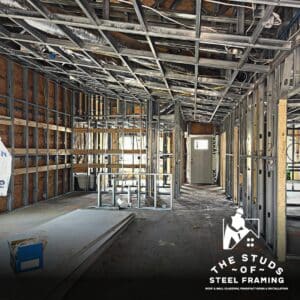How Light Gauge Steel Framing Supports Energy Efficiency in Commercial Buildings
Energy efficiency has become a top priority for commercial building owners and developers as they strive to reduce operational costs and environmental impact. Light Gauge Steel (LGS) framing plays a crucial role in improving the energy efficiency of commercial buildings, offering benefits such as enhanced thermal performance, compatibility with modern insulation systems, and reduced energy consumption. In this post, we’ll explore how LGS framing contributes to energy-efficient commercial construction and why it’s an ideal choice for developers in Florida.
1. Reduced Thermal Bridging for Improved Energy Efficiency
One of the most significant advantages of Light Gauge Steel framing is its ability to reduce thermal bridging, which occurs when heat transfers through more conductive materials in a building’s envelope.
- Minimized Heat Transfer: LGS framing is designed to minimize the transfer of heat between the interior and exterior of a building. This is achieved by reducing the contact points where thermal bridging typically occurs, such as at studs and joints. As a result, less heat escapes in the winter, and less cool air escapes in the summer.
- Energy Savings in Florida’s Climate: In Florida’s hot climate, reducing thermal bridging is crucial for keeping indoor spaces cool without overworking the air conditioning system. By minimizing heat transfer, LGS framing helps maintain a consistent indoor temperature, leading to significant energy savings for commercial property owners.
By reducing thermal bridging, LGS framing enhances the overall energy performance of the building, helping developers create structures that are more energy-efficient and environmentally friendly.
2. Compatibility with High-Performance Insulation Systems
Another key factor in improving the energy efficiency of commercial buildings is the use of high-performance insulation. LGS framing is fully compatible with modern insulation systems, which helps create a more energy-efficient building envelope.
- Efficient Insulation Installation: LGS framing systems are designed to work seamlessly with a variety of insulation types, including spray foam, rigid foam, and batt insulation. This ensures that insulation fits tightly around the framing, reducing air leakage and improving overall energy performance.
- Enhanced Thermal Resistance: By combining LGS framing with advanced insulation materials, developers can create commercial buildings with a high R-value (a measure of thermal resistance), which reduces the amount of energy needed for heating and cooling.
The ability to integrate high-performance insulation with LGS framing ensures that commercial buildings maintain their energy efficiency, reducing utility costs and supporting sustainable construction practices.
3. Durability and Long-Term Energy Savings
The durability of Light Gauge Steel framing also plays a role in enhancing the long-term energy efficiency of commercial buildings. Steel’s resistance to environmental factors such as moisture, pests, and fire ensures that the building envelope remains intact and efficient for decades.
- No Warping or Deterioration: Unlike wood, steel does not warp, shrink, or degrade over time. This means that the building envelope remains tight and energy-efficient, without the need for frequent repairs or replacements.
- Maintained Structural Integrity: Because LGS framing maintains its strength and stability, it continues to support insulation and air barriers effectively throughout the life of the building, ensuring that energy efficiency is maintained long-term.
By using a durable material like steel, developers can ensure that their buildings remain energy-efficient for years to come, reducing the need for costly energy-related upgrades or repairs.
4. Energy Efficiency and LEED Certification
For commercial developers pursuing LEED (Leadership in Energy and Environmental Design) certification, energy efficiency is a critical component of achieving certification points. Light Gauge Steel framing can help developers earn these points by contributing to the building’s overall energy performance.
- Energy and Atmosphere Credits: LGS framing can contribute to the Energy and Atmosphere category of LEED certification, which rewards buildings that are designed to reduce energy consumption. The use of energy-efficient materials like LGS helps developers achieve the required energy performance standards.
- Sustainability and Reduced Carbon Footprint: By reducing energy consumption through better insulation and thermal performance, LGS framing supports the overall sustainability goals of LEED-certified buildings. This contributes to a lower carbon footprint and long-term environmental benefits.
The energy efficiency benefits of LGS framing make it an attractive option for developers seeking LEED certification or other green building standards, helping them create buildings that are both sustainable and cost-effective.
5. Lower Energy Costs for Building Owners
One of the most tangible benefits of using Light Gauge Steel framing in commercial construction is the reduction in energy costs for building owners. By improving the building’s thermal performance and reducing the amount of energy needed for heating and cooling, LGS framing leads to significant savings over time.
- Reduced Cooling Costs in Hot Climates: In Florida, where cooling costs are a major concern, the energy efficiency benefits of LGS framing can result in substantial savings on air conditioning. By keeping cool air inside the building and minimizing heat gain from the outside, building owners can lower their monthly energy bills.
- Increased Return on Investment (ROI): Energy-efficient buildings are more attractive to tenants and buyers, as they offer lower operating costs. By reducing energy consumption, building owners can increase the ROI of their commercial properties, making them more competitive in the market.
The long-term cost savings associated with energy-efficient LGS framing make it a smart investment for developers and building owners looking to reduce operational expenses.
6. Environmental Impact and Sustainability
In addition to its energy-saving benefits, Light Gauge Steel framing contributes to the overall sustainability of commercial buildings by reducing their environmental impact.
- Lower Energy Consumption: By improving energy efficiency, LGS framing helps commercial buildings use less energy, reducing their contribution to greenhouse gas emissions. This is especially important as businesses and developers work to meet stricter environmental regulations and sustainability goals.
- Supporting Sustainable Construction Practices: The use of energy-efficient materials like LGS framing supports sustainable construction practices, helping developers create buildings that are both environmentally friendly and cost-effective.
By reducing energy consumption and supporting sustainable building practices, LGS framing helps developers create commercial properties that are better for the environment and more cost-efficient to operate.
Conclusion: LGS Framing for Energy-Efficient Commercial Buildings
In today’s energy-conscious world, developers are looking for building materials that offer both performance and sustainability. Light Gauge Steel framing provides the perfect solution, offering improved thermal performance, compatibility with high-performance insulation, and long-term durability that ensures energy efficiency over the life of the building. For commercial projects in Florida, where energy costs can be high, LGS framing offers a smart, sustainable way to reduce costs and environmental impact.
Contact Elite Steel Today! Looking to improve the energy efficiency of your next commercial project? Contact Elite Steel at 1-904-799-6499 or visit elitesteel.com to learn more about how Light Gauge Steel framing can help you achieve your energy efficiency goals.


